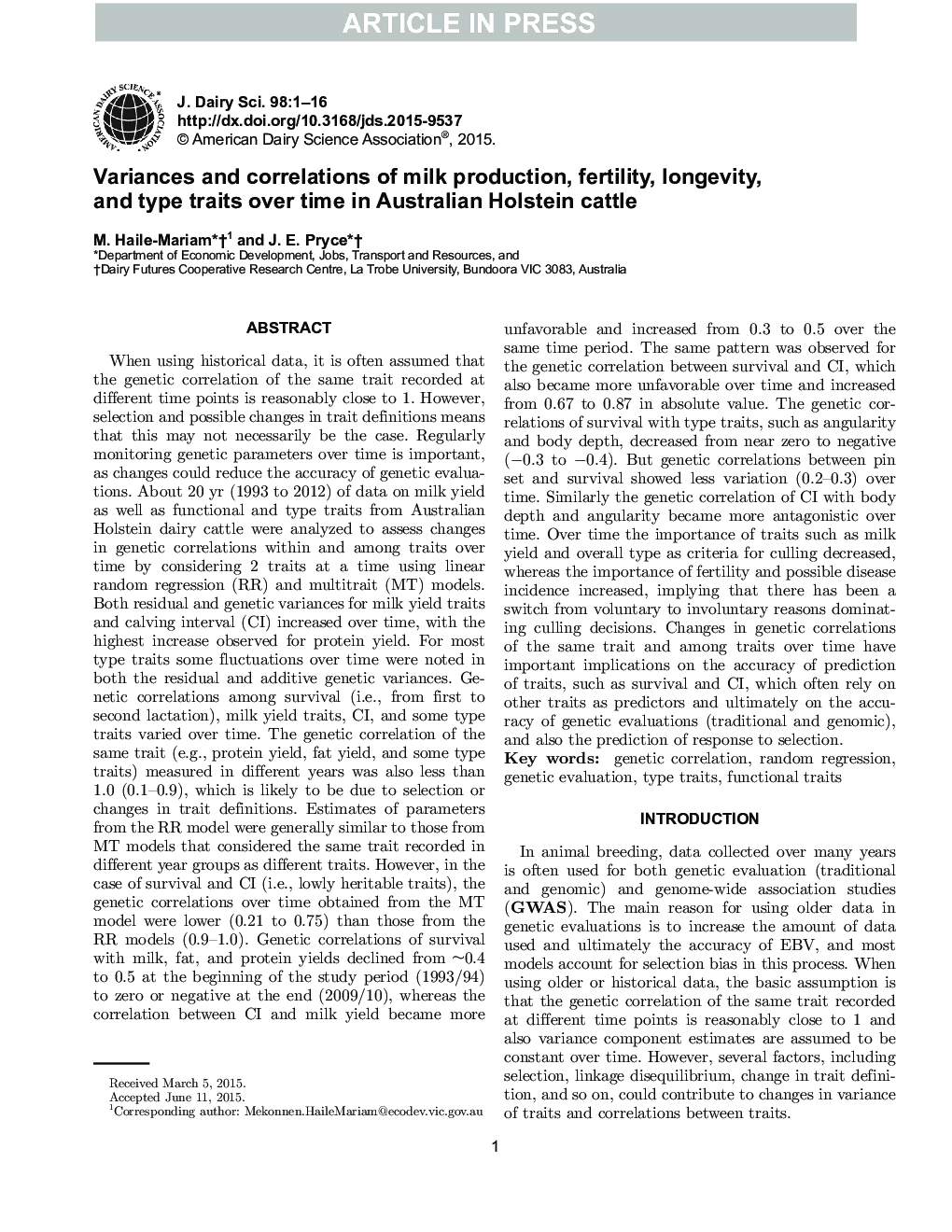| کد مقاله | کد نشریه | سال انتشار | مقاله انگلیسی | نسخه تمام متن |
|---|---|---|---|---|
| 10974968 | 1108029 | 2015 | 16 صفحه PDF | دانلود رایگان |
عنوان انگلیسی مقاله ISI
Variances and correlations of milk production, fertility, longevity, and type traits over time in Australian Holstein cattle
ترجمه فارسی عنوان
اختلافات و همبستگی های تولید شیر، باروری، طول عمر و صفات نوعی در گاوهای هلشتاین استرالیا
دانلود مقاله + سفارش ترجمه
دانلود مقاله ISI انگلیسی
رایگان برای ایرانیان
کلمات کلیدی
همبستگی ژنتیکی، رگرسیون تصادفی، ارزیابی ژنتیکی، صفات نوع صفات کاربردی،
موضوعات مرتبط
علوم زیستی و بیوفناوری
علوم کشاورزی و بیولوژیک
علوم دامی و جانورشناسی
چکیده انگلیسی
When using historical data, it is often assumed that the genetic correlation of the same trait recorded at different time points is reasonably close to 1. However, selection and possible changes in trait definitions means that this may not necessarily be the case. Regularly monitoring genetic parameters over time is important, as changes could reduce the accuracy of genetic evaluations. About 20 yr (1993 to 2012) of data on milk yield as well as functional and type traits from Australian Holstein dairy cattle were analyzed to assess changes in genetic correlations within and among traits over time by considering 2 traits at a time using linear random regression (RR) and multitrait (MT) models. Both residual and genetic variances for milk yield traits and calving interval (CI) increased over time, with the highest increase observed for protein yield. For most type traits some fluctuations over time were noted in both the residual and additive genetic variances. Genetic correlations among survival (i.e., from first to second lactation), milk yield traits, CI, and some type traits varied over time. The genetic correlation of the same trait (e.g., protein yield, fat yield, and some type traits) measured in different years was also less than 1.0 (0.1-0.9), which is likely to be due to selection or changes in trait definitions. Estimates of parameters from the RR model were generally similar to those from MT models that considered the same trait recorded in different year groups as different traits. However, in the case of survival and CI (i.e., lowly heritable traits), the genetic correlations over time obtained from the MT model were lower (0.21 to 0.75) than those from the RR models (0.9-1.0). Genetic correlations of survival with milk, fat, and protein yields declined from ~0.4 to 0.5 at the beginning of the study period (1993/94) to zero or negative at the end (2009/10), whereas the correlation between CI and milk yield became more unfavorable and increased from 0.3 to 0.5 over the same time period. The same pattern was observed for the genetic correlation between survival and CI, which also became more unfavorable over time and increased from 0.67 to 0.87 in absolute value. The genetic correlations of survival with type traits, such as angularity and body depth, decreased from near zero to negative (â0.3 to â0.4). But genetic correlations between pin set and survival showed less variation (0.2-0.3) over time. Similarly the genetic correlation of CI with body depth and angularity became more antagonistic over time. Over time the importance of traits such as milk yield and overall type as criteria for culling decreased, whereas the importance of fertility and possible disease incidence increased, implying that there has been a switch from voluntary to involuntary reasons dominating culling decisions. Changes in genetic correlations of the same trait and among traits over time have important implications on the accuracy of prediction of traits, such as survival and CI, which often rely on other traits as predictors and ultimately on the accuracy of genetic evaluations (traditional and genomic), and also the prediction of response to selection.
ناشر
Database: Elsevier - ScienceDirect (ساینس دایرکت)
Journal: Journal of Dairy Science - Volume 98, Issue 10, October 2015, Pages 7364-7379
Journal: Journal of Dairy Science - Volume 98, Issue 10, October 2015, Pages 7364-7379
نویسندگان
M. Haile-Mariam, J.E. Pryce,
